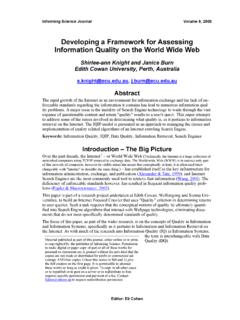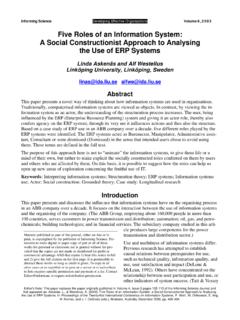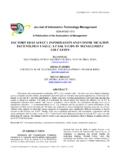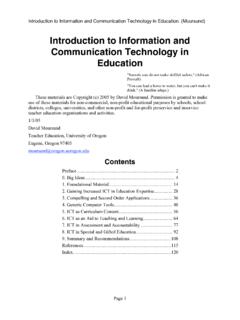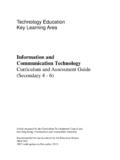Transcription of Information and Communication Technology: …
1 Informing Science Journal Special Series on Community Informatics Volume 6, 2003 Series Editors: Eugene Rathswohl and Charles Winer Information and Communication technology : gender Issues in developing nations Kimberly Betz Leahy and Ira Yermish St. Joseph s University, Philadelphia, PA, USA Abstract As developing nations seek to leverage scarce resources toward the goal of achieving a developed status they must reevaluate past practices and explore available and affordable technologies. Where in-formation and Communication infrastructures are weak, use of low-cost, easily distributed technologies have proven effective. Still, many developing nations have failed to incorporate a resource in great abundance, their women, to use these new technologies to greatest advantage. This paper will address the implications of women s lack of economic and educational parity, and offer examples of how the education of women through the use of Information and Communication technology can enhance a na-tion s gross domestic product (GDP).
2 Keywords: developing nations , IT Education, gender Issues Introduction In the space of one generation, Information and Communication technology (ICT) has changed the global macroeconomic landscape. Business leaders, educators, and politicians all have watched as for-merly subsistence economies leveraged ICT to become indispensable knowledge resources to the titular heads of world commerce. Countries that less than ten years ago relied on foreign aid to feed their peo-ple, today supply value-added Information services to mature and nascent economies alike. developing nations , whose exports once consisted primarily of raw materials and farming production, now proclaim to the world the technical proficiency of their knowledge workers. Even in societies where ICT has just begun to take root, rural villagers make use of the Internet to bring their goods to the international mar-ket.
3 nations that capitalized on the Information technology age have recognized significant return on their initial ICT investments. We as an interdependent global community have experienced in real terms the positive economic change that shared understanding and open Communication have fostered in formerly marginalized societies. With ICT, the knowledge required to make economic revolution happen can now be accessed by developing nations , bringing about a level of education and economic opportunity hitherto unimagined. The economic benefits of an educated society have long been tied to improved standards of liv-ing; numerous studies have linked the two, and few would argue that the increased wealth of a nation s people is not a positive externality of education. Over the past ten years, ICT has con-tributed to increased education levels, and, by im-plication, income levels, around the world.
4 From introducing distance learning to the first-time stu-dent in a developing nation, to job-skill training in Material published as part of this journal, either on-line or in print, is copyrighted by the publisher of Informing Science. Per-mission to make digital or paper copy of part or all of these works for personal or classroom use is granted without fee pro-vided that the copies are not made or distributed for profit or commercial advantage AND that copies 1) bear this notice in full and 2) give the full citation on the first page. It is permissible to abstract these works so long as credit is given. To copy in all other cases or to republish or to post on a server or to redistribute to lists requires specific permission and payment of a fee. Contact to request redistribution permission. Information and Communication technology 144 countries resurrecting their domestic industries, ICT has facilitated Communication and vital knowledge transfer across six continents.
5 Still, even with the accessibility to educational resources that ICT represents, some countries elect not to take full advantage of ICT s potential with respect to nearly half their own people. Women, on average, represent fifty percent of a given nation s populace; yet in most developing countries, women represent far less than fifty percent of the nation s intellectual capital, skilled labor pool, and economic contribu-tion. For reasons beyond the scope of this discussion, some nations do not afford the same freedoms and opportunities for education to all their citizenry. Consequently, these nations overlook fifty percent of their most valuable natural resource: human potential. developing nations experiencing skilled labor shortages have heard their women express the desire and ability to learn and work. However, in many countries, strong cultural prohibitions still exist against educating women and allowing them access to employment.
6 These same countries lament their dearth of Communication technology workers, even as they hear their women beg to be given economic opportunities. That extending opportunity to women results in a lessening of opportunity for men is a specious argument. When a country fully leverages all its assets, discovery leads to innovation, resulting in greater opportunity for everyone. Women represent three quarters of all heads of households in developing nations , and for every one woman in poverty there are four children, (UNICEF, 2001). Perhaps out of habit, developing nations have continued to spend scarce economic resources on the consequences of illiteracy, yet have not taken the one step that could solve the problem in one generation: educating their women. World leaders have for decades asserted education as a basic human right. The rulers of some develop-ing nations have felt otherwise.
7 The following discussion recognizes and affirms the importance of a country remaining true to its culture; it would demonstrate unqualified hubris to recommend the export of Western values as a model for achieving economic parity across nations . Economics alone cannot measure the worth of cultures dating back thousands of years. Still, the basic human right of education as upheld by the United nations is being denied to women in many developing nations , often to the eco-nomic disadvantage of those nations . This paper will not be another shrill voice for the world s despots to apply Kantian principles toward the equal governing of their people. Nor will it suggest that but for women s educational disenfranchisment, the economic crises of the world would be resolved. This pa-per will, however, offer a compelling argument to incite world leaders to educate the full complement of their respective societies.
8 By first outlining the costs of female illiteracy, both to today s generation and to its progeny, then citing concrete examples of economic turn-around in societies offering equal educational opportunity to women, this paper will illustrate the economic imprudence of a country s refusing to educate every last one of its willing and able adults. The discussion will include a summary of the state of women s educa-tion around the globe and its concomitant poverty. It will offer Communication technology -based, knowledge transfer solutions to most expeditiously provide women with educational opportunity. The discussion will give examples of organizations, both government and non-government, available as re-sources to developing nations wishing to endow women with the rights of education and employment. It will cite numerous quotations from authorities in global economic and educational policy concerning the undeniability of the value of women s education.
9 It will show where success toward those goals has been achieved, and examples of where women s use of ICT in the developing nation workplace could successfully be applied. This discussion will indicate how through organic growth as well as foreign direct investment, a nation might bring about positive economic change by opening opportunity to its entire people. This paper will not judge any nation s culture, politics, or economic condition. This paper will only offer alternatives to current economic and educational practices, and illustrate how Information Communication technology might foster positive change. Clearly, offering women educational opportu-nities alone will not provide complete economic turnaround for all developing nations . Yet it remains an area untried and one with proven outcomes. Leahy & Yermish 145 Women, Poverty and Education Women are still the poorest of the world s poor, representing 70 percent of the billion people who live in absolute poverty, (Data and Statistics, 2001).
10 Nearly 900 million women have incomes of less than one US dollar per day, (UNESCO, 2001) the equivalent of the population of the United States times three. In the world today, 880 million people are considered illiterate; that is, as defined by the UN, the inability to read 40 words per minute, write 20 words per minute, and do two-digit arithmetic, (UNESCO, 2001). Two thirds of the world s 880 million illiterate are women, a statistic that has re-mained unchanged for ten years, (UNESCO, 2001). For these 590 million women and their respective countries, the correlation between literacy and economic contribution cannot be overstated. Concerning the link between women in poverty and literacy, World Bank President James D. Wolfensohn, in his speech to the World Education Forum in Dakar Senegal, April 27, 2000, said, No country has suc-ceeded without educating its people; education is key to sustaining growth and reducing poverty.
